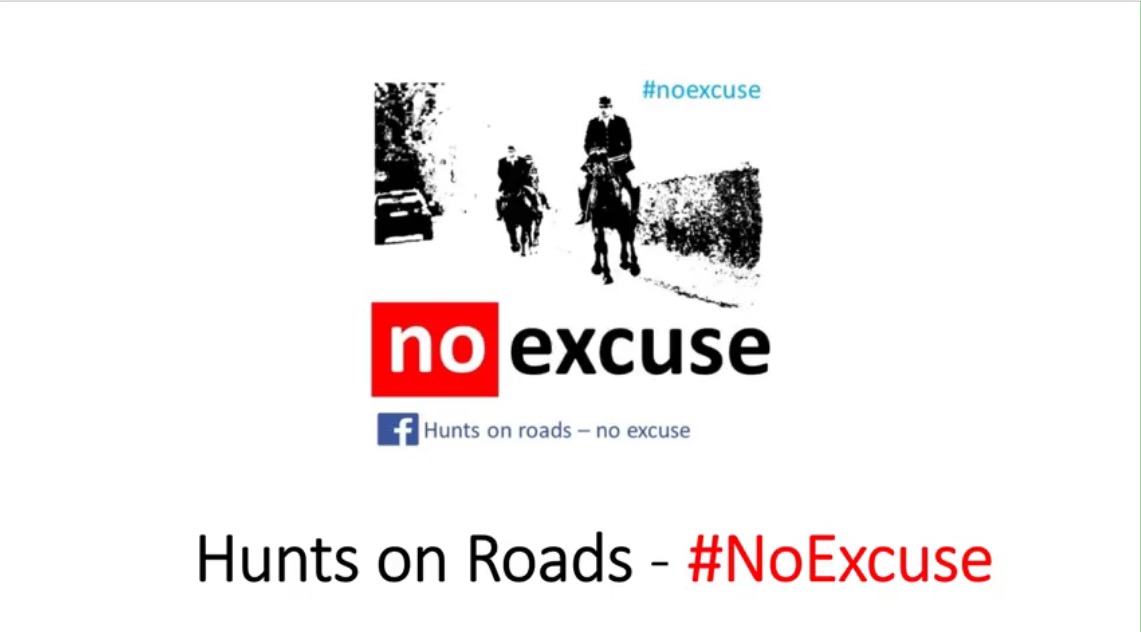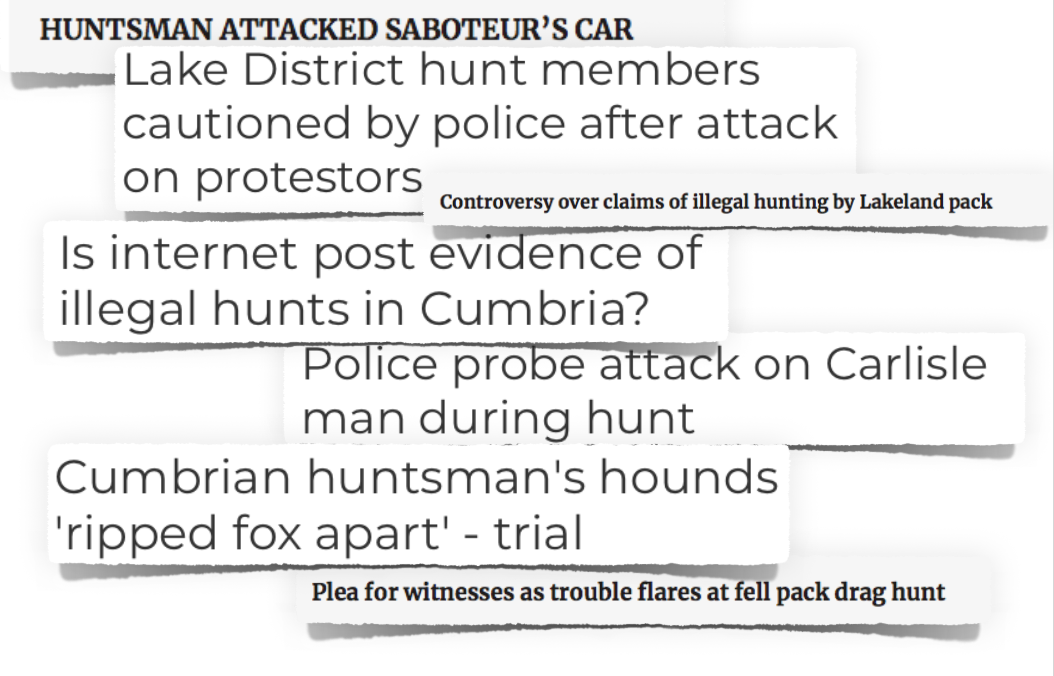13th March 2019
Locals Against the Weston and Banwell Harriers
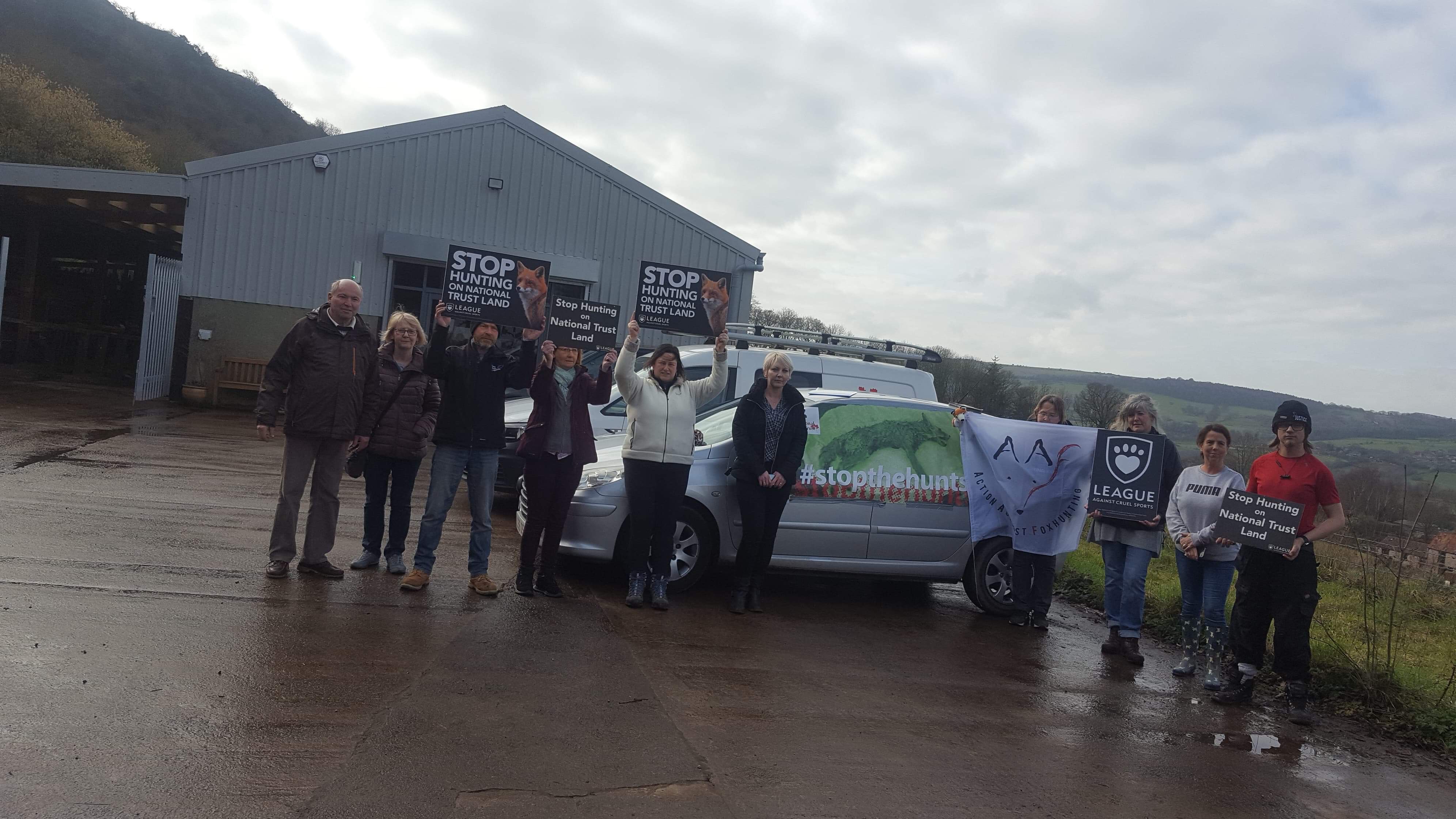 Locals Against the Weston and Banwell Harriers outside National Trust offices at Crooked Peak, Somerset on Friday 1st April 2019. Photo © Locals Against the Weston and Banwell Harriers.
Locals Against the Weston and Banwell Harriers outside National Trust offices at Crooked Peak, Somerset on Friday 1st April 2019. Photo © Locals Against the Weston and Banwell Harriers.
The Weston and Banwell Harriers are a furtive bunch of hunters operating southwest of Bristol. The way they carry on is suspicious to say the least. For instance, why would a legal hunt be involved with blocking badger setts? Consequently, local residents have been trying to persuade the National Trust to withdraw their permission for so-called trailhunting on land which by definition should provide a sanctuary for wildlife.
Locals Against the Weston and Banwell Harriers met with National Trust staff on Friday March 1st. Afterwards, we asked them to let us know their thoughts;
“We attended with Maria Burt who started a petition against so-called trailhunting on National Trust land and set up the meeting, and Jac Freeman from the League Against Cruel Sports. We knew going into the meeting that there was a big likelihood that the licence wouldn’t be revoked but we wanted to give our best shot anyway for the wildlife that calls Wavering Down its home.
“With all our evidence in hand we explained to Nick Droy (National Trust Trailhunting Manager) and the National Trust Wavering Down Team that we didn’t believe the Weston & Banwell Harriers would stay in the rules of the trail hunting licence as they had already sett blocked once this year.
“But sadly and frustratingly this went over their heads and they used the usual excuse that a lot of money had been invested into trail hunt monitoring on their land.
“Giving a hunt notice that they will be monitored just means that they will behave when being monitored by the National Trust.
“How a conservation organisation can support hunting that can and will damage our ecosystem baffles us.
“But our determination to make Wavering Down and Somerset a safe haven for wildlife will continue.
“Hunting is a cruel out of date past time that has no place and is not welcomed. And neither are the Weston and Banwell Harriers, who have been terrorising our wildlife for years unchallenged. Our main aim is to bring an end to this and show them some resistance. We will do all we can to stop them needlessly killing wildlife for sport and fun!
“A big thank you again to everyone that came Friday your support was amazing! And a big thank you to the National Dis-Trust for all the advice and guidance!
“For our wildlife always.”
https://www.facebook.com/localsagainstwestonandbanwellharriers/
Hotline number: 07946663765
Email: [email protected]
© Locals Against the Weston and Banwell Harriers
18th October 2018
Government Defends Wildlife Crime On Public Land
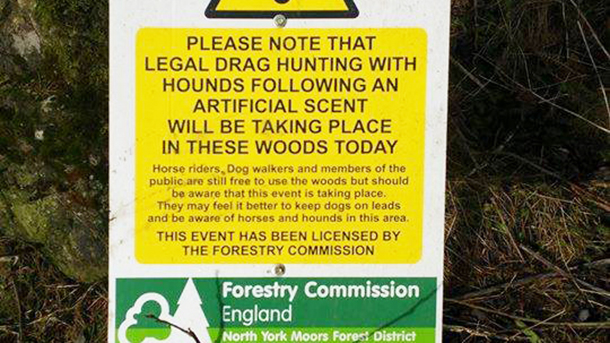 Forestry Commission sign warning of a 2016 drag hunting event at North York Moors, where no actual drag hunt operates. Photo courtesy International Fund for Animal Welfare
Forestry Commission sign warning of a 2016 drag hunting event at North York Moors, where no actual drag hunt operates. Photo courtesy International Fund for Animal Welfare
GOVERNMENT DEFENDS WILDLIFE CRIME IN PUBLICLY OWNED FORESTS
Yesterday, the Department for Environment, Food & Rural Affairs responded to a petition calling for an end to the licensing of so-called ‘trail hunts’ on the Public Forest Estate, which is owned & managed by the Forestry Commission on behalf of the public. The response is pretty much a paraphrased Countryside Alliance press release and there are a couple of things they’ve either overlooked, perhaps accidentally, perhaps not:
- The petition specifically doesn’t call for an end to licences given to hunts which have agreements formed under a general agreement with the Master of Draghounds & Bloodhounds Association (MDBA), as drag hunting & clean boot hunting are not covers for wildlife crime.
- DEFRA’s response omits that licences are also granted to hunts under a general agreement with the Association of Masters of Harriers & Beagles (AMHB), such as the New Forest Beagles.
Most importantly, though, they’ve regurgitated one of the most worn out lies in the country and they’ve done so without scrutiny. This is, of course, that fox & hare hunts have stopped hunting live quarry and started to ‘trail hunt’.
‘Trail hunting is a legitimate activity … Many hunts have since turned to trail hunting as an alternative to live quarry hunting…’ – DEFRA, 17th October 2018.
Here’s a couple of brief reasons why this is rubbish:
- In 2014, a review of RSPCA prosecuting activity was published by Stephen Wooler CB, a former Chief Inspector for the Crown Prosecution Service. On P109/s9.1 it stated that: ‘The evidence reviewed leaves no room for doubt that, despite the 2004 legislation, traditional fox hunting remains “business as usual” in many parts of the country.’
- Both before & after the Wooler Review, hunts that have been licensed to use public land by the Forestry Commission have been convicted; the Meynell & South Staffordshire Hunt were convicted under the Hunting Act 2004 based on footage from Derby Hunt Saboteurs and the Cottesmore Hunt were convicted under the Protection of Badgers Act 1992 based on footage from the League Against Cruel Sports.
DEFRA have rejected the requests of the petition on a completely false premise. It remains open & ongoing to gain signatures, and needs 100,000 signatures before 18th March 2019. If you haven’t signed this already, please do so here!
© Jack Riggall
2nd September 2018
Hunts On Roads - #NoExcuse
One of the most extraordinary photos Surrey Hunt Monitors has taken is of Morestead Road, near Winchester. It’s an unremarkable road, but at about 2.15pm on Saturday 27 January 2018 it looked like a canine racetrack.
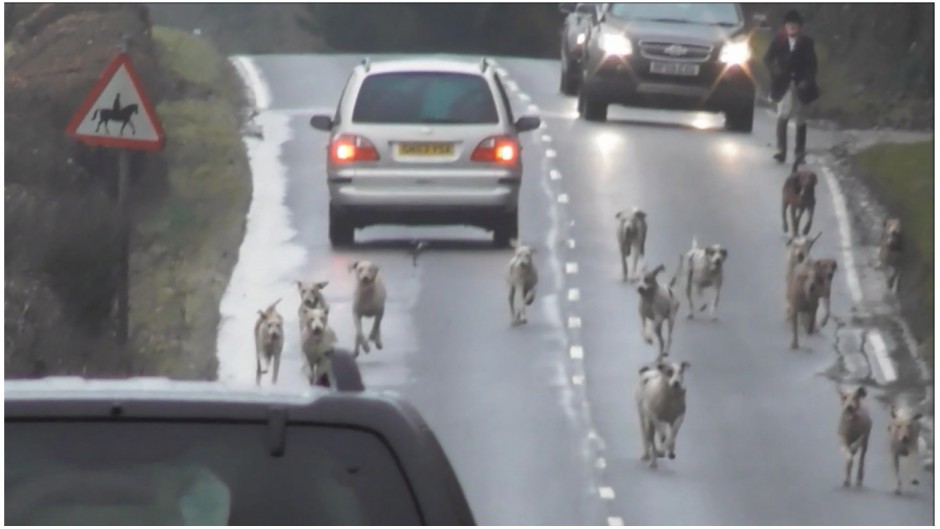
Funny old place to lay a trail. It would be almost as stupid as on the A1(M) motorway in North Yorkshire (28 January 2017), or through a cat sanctuary in Kent (9 January 2018).
Of course it wasn’t actually the case that a trail was laid in any of these places. In each case the hounds had been following animal scents. In the Morestead Road case, the scent was of two deer which had been chased by the hounds and had crossed the road a short while before.
What happened next was referred to on Twitter as #HuntHavoc. It’s a very appropriate term. It risks lives, not just of the animals being chased and the hounds doing the chasing, but also the people driving on the roads who, at any moment can find themselves in the wrong place at the wrong time, like the driver of this car who had to make an emergency stop and swerve to avoid one of the Morestead Road hounds as it emerged from the undergrowth along the side of the road and into his path:
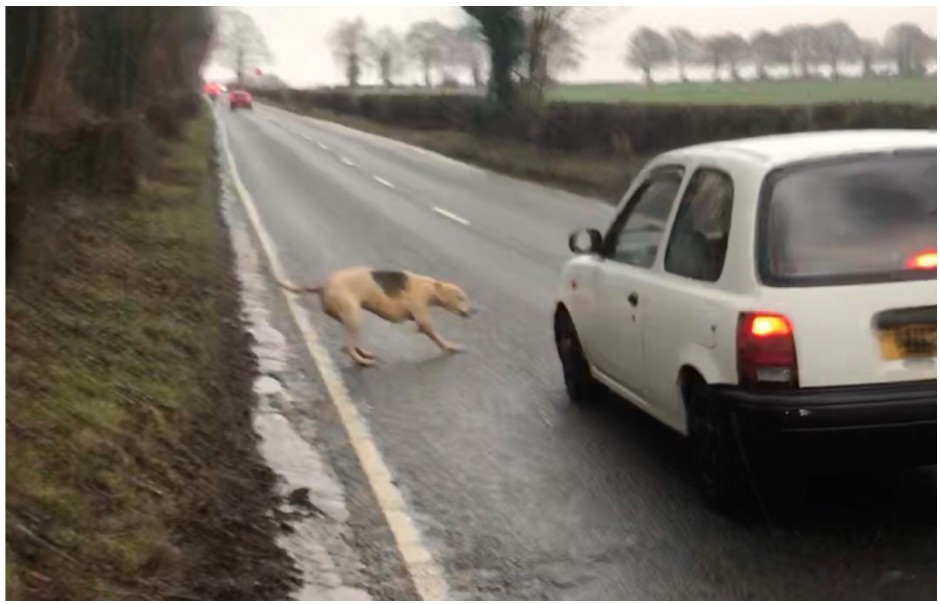
For a video of this on Twitter see here.
A driver cannot help his or her instincts. See a dog run out in front of you, and you will do as he did and swerve as well as brake. If a car had been coming the other way, a very nasty collision could well have occurred.
So whose fault would it have been? Not the driver’s, but the owner of the hound. And that’s because dogs on roads are inherently dangerous that the Road Traffic Act 1988 contains a provision - Section 27, subsection (1) - which makes it a criminal offence to cause or permit a dog to be on a road without the dog being held on a lead.
So isn’t it obvious then, that the owners of hounds which go on roads are committing an offence? Actually, no. As with all legal issues connected with hunting, its not so simple as that. The hunting lobby had powerful friends in Parliament when this Act was passed and they ensured an exception for hunts. It reads: “subsection (1) … does not apply to dogs proved … to have been at the material time in use under proper control for sporting purposes”. Hence it is perfectly legal, whilst out hunting, for a pack of well-behaved hounds to trot along a country lane with the hunt in the classic picture-postcard image hunts like to portray.
But the key words for this purpose are “under proper control”. In what possible sense is a hound under proper control if it is on a public road chasing a fox or deer? In the Morestead Road case, it was such a clear cut situation that the local (Hampshire) police investigated and interviewed the relevant hunt, the Hursley Hambledon Hunt. The matter appears to be nearly resolved with a Community Resolution Order, meaning that the hunt accepts responsibility and writes a letter of apology. Whilst not a conviction, it is a step on that road (if the pun will be forgiven) and the Hursley Hambledon Hunt will have to be much more careful in this coming season, since the next offence would likely mean a caution, and the one after that a court appearance.
The “squeeze”
However, there can be other cases where it is arguably not so clear. The hounds may not be on the road for so long, for example, with the hunt arguing the hounds were in fact under control. This is when what lawyers like to call a “squeeze” can be brought into play.
Consider a case where a hunt is accused of unlawful hunting under Section 1 of the Hunting Act 2004. The defence is invariably of “accident”: the hounds were following a trail when they just happened to come across a fox and chased it. The recent Grove and Rufford and Portman Hunt cases are just two examples. Hounds could not be called back (despite best efforts, of course). Or the huntsman was not sufficiently close to the hounds to be in control and hence responsible. But if the huntsman was not close enough to control his hounds, or was close, but not able to control them, and they cross a road, the Section 27 offence surely cannot be avoided: there is a “squeeze” between the two offences. In order to escape the Hunting Act offence, the hunt is inescapably admitting (indeed positively claiming) a lack of control and hence the commission of an offence under the Road Traffic Act.
Hound exercise
Another activity undertaken by hunts is “hound exercise”. This is in principle an unobjectionable behaviour in as far as the hounds are simply taken out for a run. If only hunting were replaced entirely by hound exercise! However, hounds need exercise every day and it must be a significant effort to put them in a van and drive them to somewhere safe to get this. Hence it’s not surprising that some hunts use roads to access nearby fields.
The question is, does the hunting exemption then apply? The clear answer is “no”. To repeat, the relevant language of the defence is (emphasis added): “subsection (1) … does not apply to dogs proved … to have been at the material time in use under proper control for sporting purposes”. The fact the hounds are used three times a week for hunting is of no relevance to the other four days of the week. There is no blanket exemption for foxhounds. When hounds are being taken out for exercise and use a road they must, like any other dog, be on a lead, or else an offence under Section 27 of the Road Traffic Act will be committed.
Some hunts are worse again and do not even bother to take the hounds to a field. One example local to Surrey Hunt Monitors is the Hampshire Hunt. They’re based in a quiet village called Ropley and here one can often see the entire pack being led around the village roads by three cyclists causing chaos:
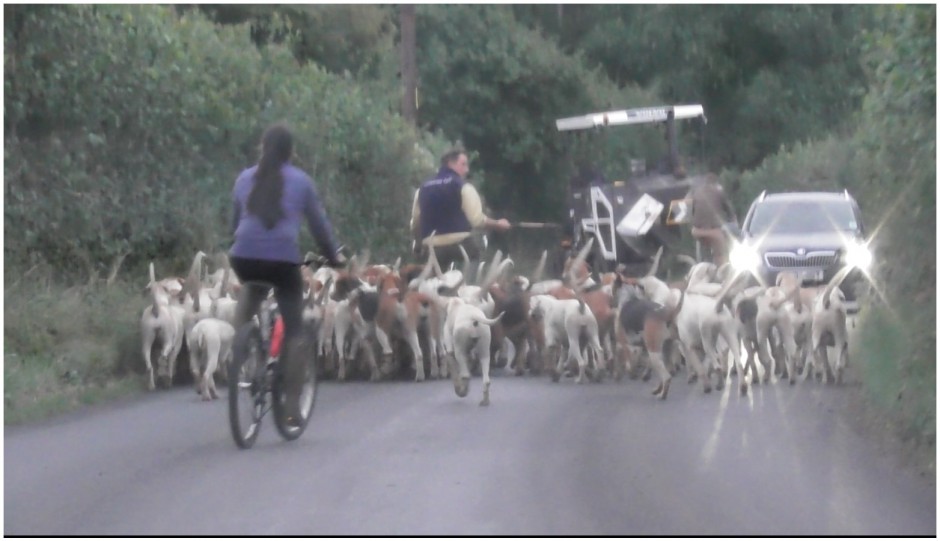
… not to mention depositing a large amount of dog mess …
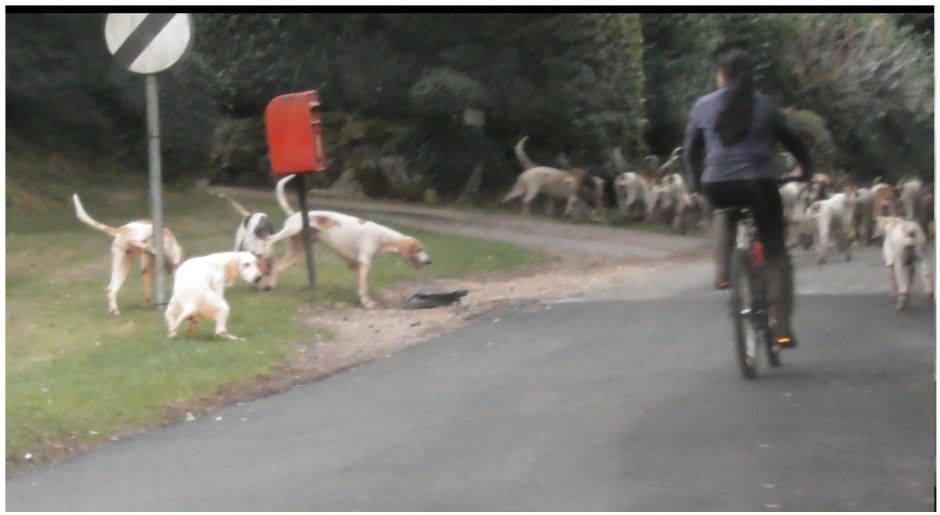
Two sample incidents have recently been reported to Hampshire police, and we await hearing from them as to if and how they intend to proceed.
Advice for Campaigners and the Public
Convictions under the Road Traffic Act are distinctly second best to Hunting Act convictions, but given the difficulty of the latter, they represent a way forward in controlling the reckless behaviour of hunts. So we offer two bits of advice;
1. If you are out early one morning hoping to catch your local hunt cubbing and only see them exercising their hounds on the local roads, dial 101 and report them under S.27 Road Traffic Act 1988. If the police say hunts are exempt, put them straight.
2. On hunt days, when hunt hounds cross a road in pursuit of a fox or deer, report both illegal hunting and the RTA offence and the chances are the hunt will walk straight into the “squeeze”. Let’s at least stop #HuntHavoc before an innocent person is killed in addition to the thousands of innocent foxes who die every year in so-called trailhunting “accidents”. After all, there is #NoExcuse.
© A Surrey Hunt Monitor
5th August 2018
The Fell Packs & #TrailHuntLies in Cumbria
As part of the wider National Dis-Trust campaign which started in Cumbria, we’re adding this to Hounds Off as a reference point for you to learn more about the fell packs, their abuse of wildlife, and why we’re calling for them to be permanently banned from National Trust land. All of the fell packs were either licensed to use Trust land for the 2017/18 season or given free reign to trespass and kill foxes. Here are a few of the ‘highlights’ of their history (click the links to learn more)…
- In November 2017, the Eskdale & Ennerdale Foxhounds were documented trespassing on National Trust land with terriermen, but subsequently received a licence anyway.
- On 06/09/2017, a representative of the fell packs told the BBC that numerous foxes are ‘accidentally’ killed each season.
- At the Peterborough Hunting Festival on 19/07/2017, huntsman for the Blencathra Foxhounds stated that his hounds can sometimes be unsupervised up to five miles away, meaning nobody knows what they are doing or what they might be killing.
- A supporter of the Melbreak Foxhounds attacked a member of Lancashire Hunt Saboteurs on 10/01/2017 who then needed hospital treatment. The hunt supporter was convicted of assault.
- The Melbreak Foxhounds supplied a fake certificate to the Trust dated 23/10/2016 to help gain a licence, and were granted further licences to use Trust land long after the lie was exposed.
- The Melbreak Foxhounds were filmed killing a fox on Trust land by Cumbria Hunt Watch on 05/11/2015.
- On 15/03/2014, the Ullswater Foxhounds were filmed killing a fox before attacking a hunt monitor, resulting in a conviction for assault.
- The Melbreak Foxhounds killed a fox on 09/03/2014 after chasing it across Trust land, resulting in a police investigation resulting in charges and the subsequent intervention of a member of House of Lords trying to defend the huntsman.
- The Blencathra Foxhounds were investigated for illegally hunting & abuse of hunt monitors in 2013.
- On 24/03/2012, walkers witnessed the Coniston Foxhounds killing a fox and police investigated claims that hunt supporters seriously attacked protestors.
- The News & Star reported on 09/01/2012 about hunting forum users allegedly admitting to illegal fox hunting whilst with the Blencathra Foxhounds.
- A supporter of the Coniston Foxhounds attacked a League Against Cruel Sports investigator on 09/03/2010, receiving a police caution.
- The terrierman for the Ullswater Foxhounds was convicted under the Hunting Act 2004 after digging out & beating a fox to death on 26/10/2009, after it had gone to ground. He continued to be employed by the Ullswater Foxhounds, which continued to be licensed by the National Trust.
- The Ullswater Foxhounds huntsman was in court on 17/09/2009 after a fox was killed by his hounds.
- Huntsman for the Coniston Foxhounds was convicted for criminal damage after smashing the windows of a hunt monitor vehicle on 19/02/2008.
- The Blencathra Foxhounds are believed to have killed a fox on National Trust land on 11/02/2006.
WHAT CAN YOU DO ABOUT THIS?
- Ask the Trust’s General Manager for Central & East Lakes firstly why the Melbreak have only been suspended, not banned, and secondly for him to stop offering licences to all fox hunts in Cumbria. His email is [email protected].
- If you live in Cumbria and want to volunteer for our campaign, please email us at [email protected] for packs of leaflets specific to Cumbria to deliver/hand out.
- Sign the Keeptheban petition to ban all hunting on National Trust land in England & Wales.
- Grass up the Cumbrian hunts if you see them by emailing Cumbria Hunt Watch on [email protected].
- Follow National Dis-Trust on Facebook and Twitter for updates.
© National Dis-Trust
1st April 2018
But….They Say They Only Hunt Trails
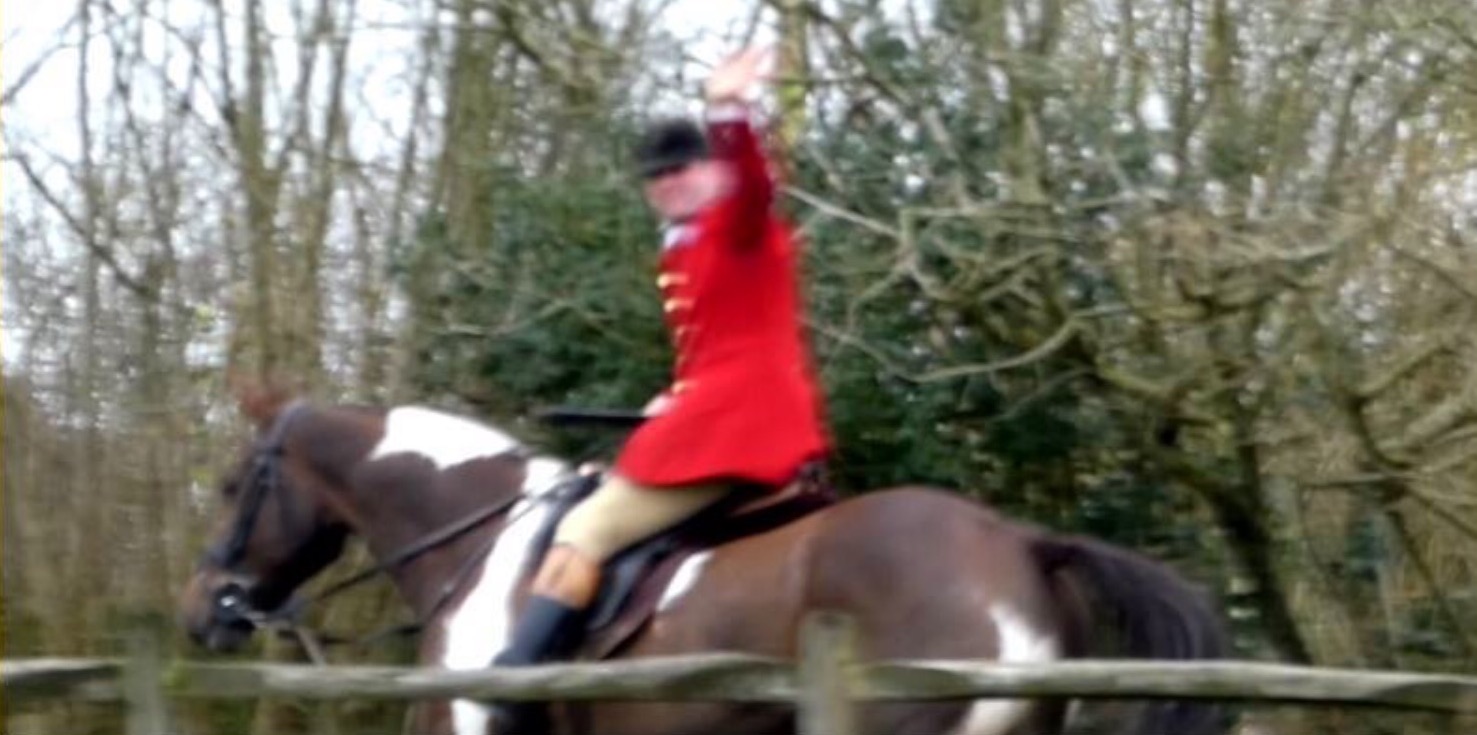 Huntsman of the Eggesford Hounds waves sarcastically at landowners who want to keep him and his hounds off Wheatland Farm in Devon (who took this pic on 30.03.18).
Huntsman of the Eggesford Hounds waves sarcastically at landowners who want to keep him and his hounds off Wheatland Farm in Devon (who took this pic on 30.03.18).
Hunts do not always respect landowner wishes. Often people ask the local hunt to keep staff, followers and hounds off their property but then it happens - again. You need patience, stamina and strong support to stand up for yourself.
Sadly hunt trespass is all too common still. Hounds Off currently supports loads of people who are bemused at the attitude and arrogance of repeat offenders. In the instance below we are also asking ourselves, “But if they chase man-laid trails with dogs that are under control, like they say they do, then how come the Eggesford hounds were running all over forbidden land for the second time this year?”
Eggesford Hunt on Popehouse Moor Again: Wheatland Farm, Devon 30 March 2018
Are you troubled by the hunt? Contact Hounds Off
© Joe Hashman
11th January 2017
The £5 Money Shot - Making Evidence Of Illegal Hunting Count
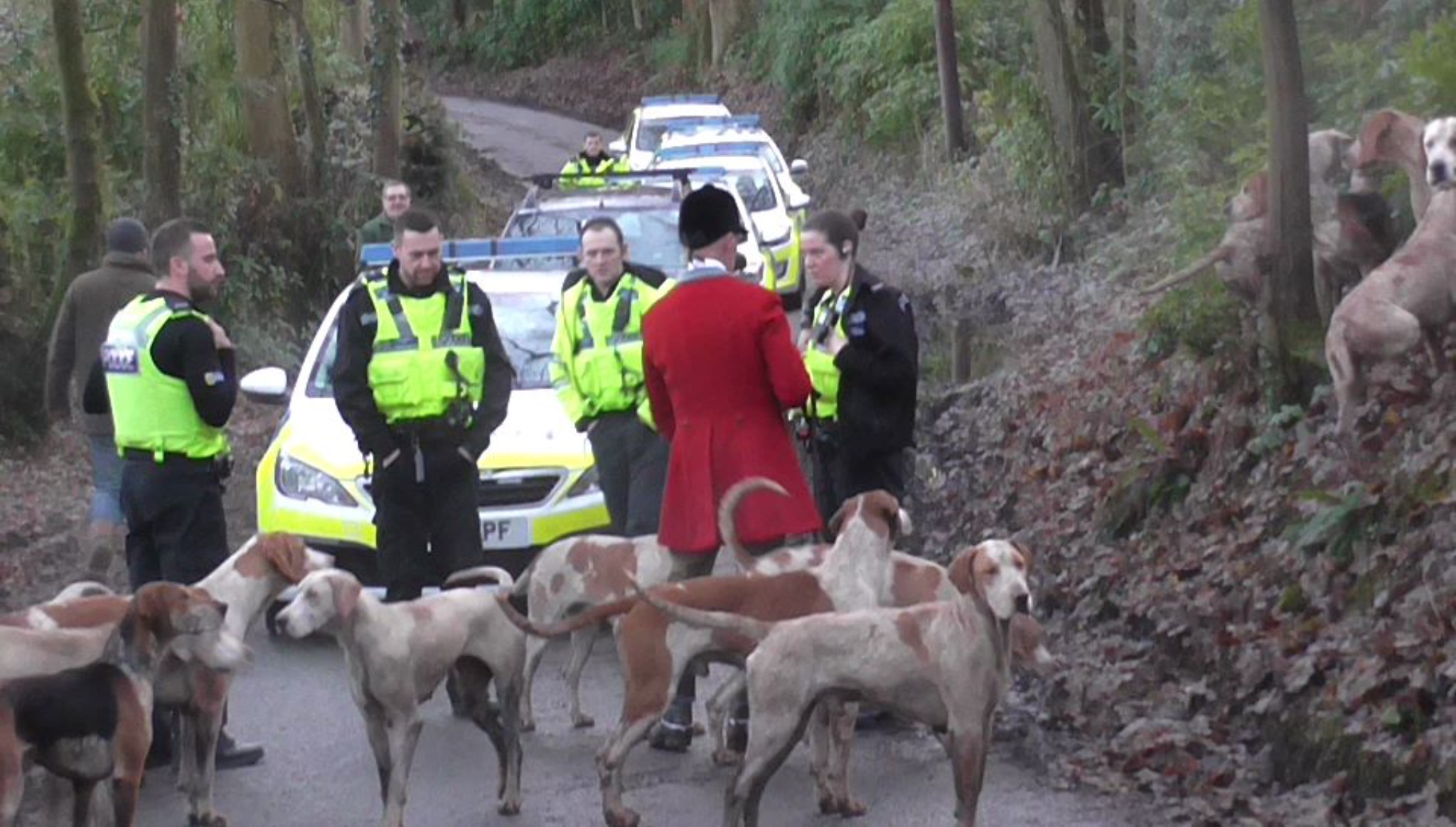 Cheshire Forest Huntsman being questioned by police, 2nd January 2017. Photo credit: Cheshire Monitors
Cheshire Forest Huntsman being questioned by police, 2nd January 2017. Photo credit: Cheshire Monitors
Did you hear about the bang-to-rights evidence of illegal hunting which the police and/or CPS weren’t interested in? Apparently it happens all the time…
It’s beyond doubt that there’s an institutional disinterest in Hunting Act cases and the authorities seek any excuse not to proceed with matters. In court, experience shows Defence teams seizing any opportunity to subvert evidence or witnesses against them. If you want your evidence to withstand close and vindictive scrutiny you need The Money Shot and, for fox sake, make it a £5er;
£1; The fox (hare, deer or mink) fleeing….
With no quarry in the frame, the Defense will argue that there is no chasing of a live animal. Establish the identity of the quarry species with your camera. You’ll need much more than film of fleeing quarry to get the offenders into court but without this you have nothing.
£2; …being chased by a pack of hounds….
A kill is not essential for an offence to be committed under the Hunting Act (2004). Chasing with dogs is illegal. Once evidence of the quarry has been secured, pan back to the hounds to show what they’re doing and how many are involved.
£3; …in view of the Huntsman or Whipper-In….
These days hounds are often allowed to range way ahead of the Huntsman. If quarry is found and chased then those responsible can claim to either not know or that it was an “accident”. Evidence which shows somebody in charge of the hounds was well able to view events makes it harder to cry “accident”.
£4; …who is not trying to stop them….
Film the behaviour of anyone at the scene including body gestures (such as pointing) and any use of horn and voice. “Accident” is far less plausible if hunt staff can be shown to have done nothing to stop the hounds. If hunt staff are filmed actively encouraging the chase (such as by cheering hounds on or doubling the horn), or by taking and acting upon information communicated to them by others then even better. This will show an intent to break the law which is hard to deny.
£5; …for a considerable time or distance.
It’s not possible to state what constitutes “considerable” but obviously the longer the chase goes on with nothing being done to stop it, the stronger the evidence of illegal hunting being an intentional thing.
Identification
When filming either Huntsman or Whipper-In take the earliest opportunity to zoom in as close as possible because identification is absolutely essential for proving who did what. Hunting Act cases will fail due to weak ident even if the actual illegal hunting is obvious. These days hunt staff often wear anonymous matching jackets and ride horses with similar colouring and features; tactics which conspire to make evidence gathering even more difficult. The smallest detail could be a clincher so be alert to capturing on film anything, anything, which could help with positive identification.
Other things: keep cameras running as long as possible; use GPS readings to verify time, date, location; don’t commentate or remonstrate whilst filming (bite your tongue if you have to - let your film do the talking); guard good evidence with your life until instructed otherwise by a professional person you trust.
The £5 Money Shot is intended to provide helpful guidance for property owners and individuals involved with law enforcement. It’s one of many wider conversations around the Hunting Act (2004). If further debate and discussion about evidence gathering of illegal hunting is prompted then good. If anyone finds it useful, applies it in the field and succeeds in court then even better!
Recommended further research:
The Hunting Act, a website for enforcement professionals
Trail Of Lies Report by IFAW and explanation of the false alibi of ‘trail hunting’
© Joe Hashman
Founder, Hounds Off
1st December 2016
The Devil’s In The Detail (But Who’s Looking?)
 Evidence of illegal hare hunting by the Easton Harriers. Photo courtesy Norfolk/Suffolk Hunt Saboteurs
Evidence of illegal hare hunting by the Easton Harriers. Photo courtesy Norfolk/Suffolk Hunt Saboteurs
HUNT TRESPASS IN WILTSHIRE
A message came to Hounds Off that hare hunting beagles breached a fence and ran into a Wiltshire garden last Saturday. Apparently the Hunt Master muttered an excuse about hunting “wounded hares”. Our Wiltshire contact said she thought hunting with dogs was banned. Something about the wounded hare excuse just didn’t ring true to us either. We asked a friend for his thoughts. He pinged them back to us in quick time.
Under the Hunting Act, there is an Exemption that allows hunting an injured hare lawfully, “for the purpose of relieving the wild mammal’s suffering” (1). However, and these are salient points in this instance, no more than two dogs may be used (2), it’s done on permitted land only (3) and the dogs must be kept under control (4).
We already know a pack was used, the hunters did not have permission to hunt in the garden and clearly they were running out of control when they did. Illegal, doncha think?
Our friend reckoned that the trespass aspect was interesting too. If the beaglers were claiming the wounded hare Exemption then they must admit to having control of their hounds - which makes the trespass deliberate. Getting to the truth would help our Wiltshire contacts should they take civil action to protect their property in future.
And here’s the frustrating bit. Why do we have to resort to civil actions? Whichever way you look at it, in 2016 hunt trespass isn’t something the anti hunting rural dweller should have to endure.
EVIDENCE OF ILLEGAL HUNTING IN SUFFOLK
As to what’s occurring with recent and ongoing allegations of illegal hare hunting in Suffolk, you might well despair. Compelling evidence gathered by Norfolk/Suffolk Hunt Saboteurs raises serious questions about the Easton Harriers and their hunting activities. Their false alibi is tenuous too. Are they claiming “rabbit hunting” or, like the Wiltshire beaglers, going after wounded hares (BBC Suffolk News online, 29 November 2016, see below)?
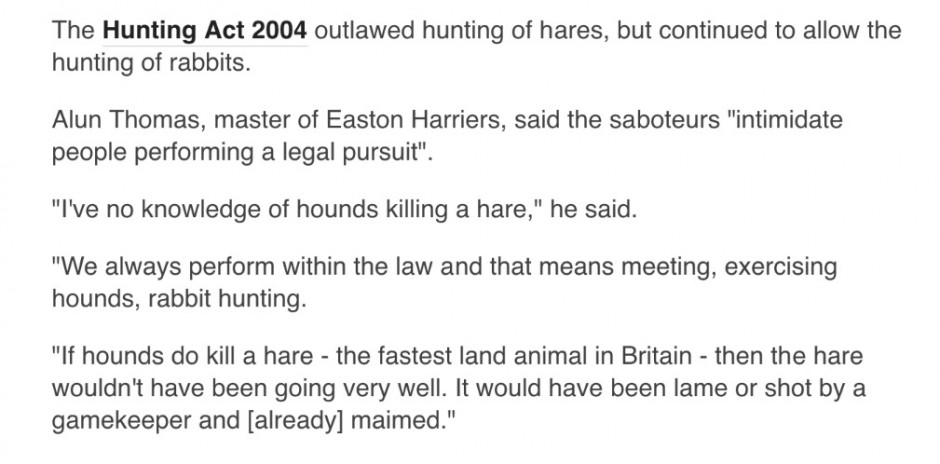
Source: http://www.bbc.co.uk/news/uk-england-suffolk-38146564
When Brian May tweeted that Law and Order had broken down in Suffolk, he joined a chorus calling out the blatantly obvious. We all hope the police and prosecuting authorities find a hitherto vacant will (and the expertise) to fully and forensically investigate these allegations of illegal hunting.
Two facts we suggest that detectives unpick early on:
1/ The dogs used are purpose-bred, specialist hare hunting hounds (ie harriers).
2/ The habitat and habits of hares and rabbits differ in basic ways which make it easy to establish what is the true quarry just by simple observation.
If, under proper scrutiny, the Easton Harriers claim the wounded hare Exemption then immediately they are guilty of illegal hunting for running more than two hounds. We could go on…
Assistant Chief Constable Rachel Kearton of Suffolk Police has appealed for information and background intelligence. We ask her to treat this blog as both, take it seriously and positively investigate. Honestly, you don’t have to be a rocket scientist to work this all out!
REFERENCES
(1) Hunting Act (2004), Schedule 1 Exempt Hunting, 8 (3).
(2) Hunting Act (2004), Schedule 1 Exempt Hunting, 8 (4).
(3) Hunting Act (2004), Schedule 1 Exempt Hunting, 8 (6) (b).
(4) Hunting Act (2004), Schedule 1 Exempt Hunting, 8 (7) (b).
ACTION TO TAKE
Request Suffolk Police investigate allegations of illegal hunting by the Easton Harriers, here
Contact Suffolk Police & Crime Commissioner Tim Passmore with your concerns, here
Make your property into a nature reserve from which hunting is forbidden, here
Write to your MP and ask them to support the Hunting Act (2004), here
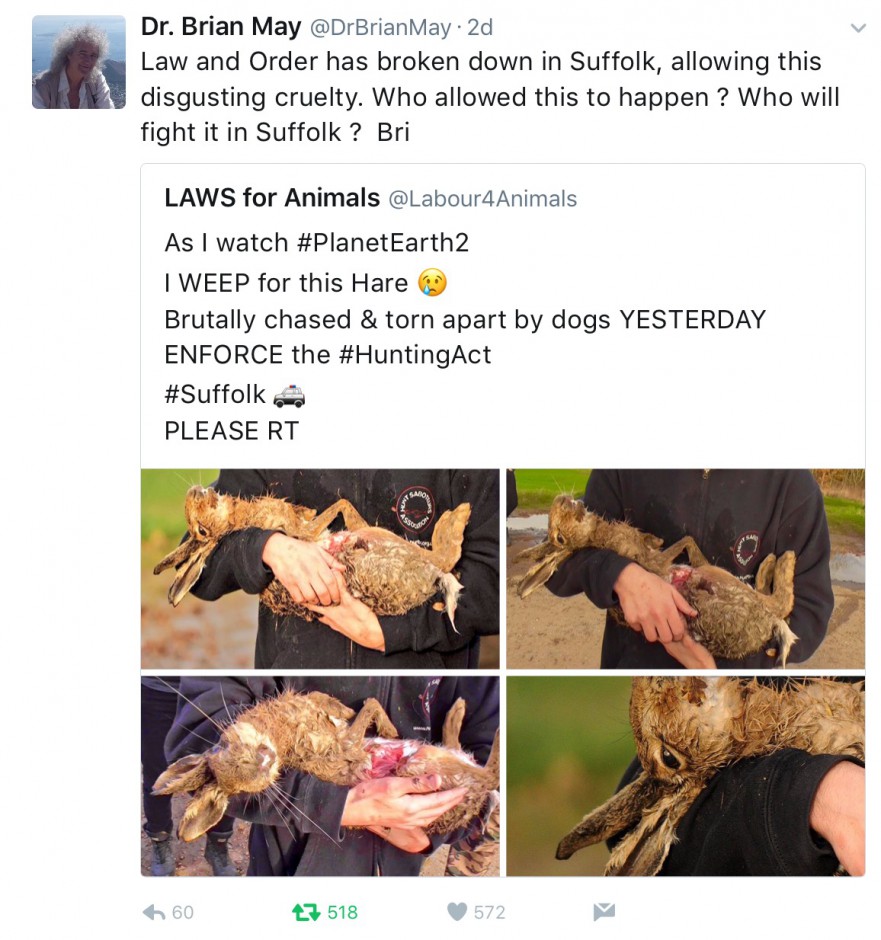
© Joe Hashman
16th December 2015
Trail Of Lies - Deconstructing & Exposing The Hunters False Alibi
 "Trail Hunting in general is nothing more than a post-hunting ban creation to provide a false alibi against accusations of illegal hunting" - International Fund for Animal Welfare
"Trail Hunting in general is nothing more than a post-hunting ban creation to provide a false alibi against accusations of illegal hunting" - International Fund for Animal Welfare
Hounds Off Founder, Joe Hashman, reports from London.
Trail Of Lies is a report by the International Fund for Animal Welfare (IFAW) which deconstructs then exposes Trail Hunting as the false alibi which many of us have always believed it to be. It was an honour to speak at the launch of Trail Of Lies yesterday in Westminster, on behalf of associates, friends and colleagues who have spent much of the last decade gathering the data and evidence upon which this report is based.
Trail Of Lies provides critical information which unveils the truth behind the false alibi of Trail Hunting and includes recommendations to solve the problem of enforcing the Hunting Act.
Here’s what I said:
The International Fund for Animal Welfare has run an Enforcement Team since the Hunting Act came into effect in 2005. During that time, in partnership with the police, RSPCA and League Against Cruel Sports, we’ve dealt effectively with attempts by the hare coursing community to rename and reinvent their pastime of choice in a way which was intended to circumvent the law. In fact, by working with our aforementioned partners, together we’ve eradicated organised club coursing from the British Isles.
The same can’t be said of fox, deer, hare and mink hunting with hounds and this is the source of great regret within our Enforcement Team. For many outside of the hunting bubble it’s hard to understand how and why these deathsports continue. The reasons are complicated, and one of them is the false alibi of Trail Hunting.
Don’t forget that the hunting community pledged to defy the Hunting Act even before it was passed. This same community vows to retain and defend the infrastructure of hunting so that, if they ever succeed in repealing the Act, full-on deathsports can resume seamlessly and without delay. Trail Hunting is a vital part of their strategy to keep hunting live quarry with hounds viable while actively degrading the Hunting Act and those who seek to enforce it, be they law enforcement agencies or NGOs such as IFAW.
The Enforcement Team has evidenced over ten years of cynical subterfuge and false alibis by hunts the length and breadth of Britain; hunts who we suspect have used Trail Hunting to pretend to be doing one thing while actively doing another.
Many of us believe that hope for a compassionate future lies in the hands of the younger generation - that the Hunting Act enshrines the will of the people but, until hunting and killing wild mammals with dogs becomes socially unacceptable, there will always be a problem. We believe our opponents know this too. That’s why Trail Hunting is so useful to them. It allows bloodsports to continue with a veneer of respectability and provides a readymade excuse if they get sussed out.
One of the changes which the Enforcement Team have noted over the last decade is that many Hunts split their day. They have a jolly ride until 2.30 or 3 o’clock and then, when folk who hunt to ride have mostly exhausted themselves and gone home, for the hard core who ride to hunt the real and illegal business begins.
Well-known in hunting circles is a phenomenon called the “3 o’clock fox”. Around this time on a winters day, atmospheric changes often make the scent left by wild animals stronger and, of coarse, from the angle of a Wildlife Crime Investigator, daylight starts fading which makes evidence gathering more difficult. We see it as no coincidence that this is frequently when the gloves come off and the business of hunting with hounds gets serious.
Integral to the continuity of deathsports is an ongoing supply of willing participants. A vital part of the infrastructure which traditionally leads horse loving youngsters into the dark world of killing-for-fun are the Pony Clubs. Most Pony Clubs are linked with mounted hunts and, so long as these hunts claim to be Trail Hunting within the law, they’re able to hoodwink many impressionable youngsters (and their parents) about their real intent. With a range of horse-related activities on offer which seem a million miles from the ritualised sacrifice of a fox, hare or deer, Pony Clubs provide a perfect gateway for introducing children into the ways of the Hunt.
Remember, Trail Hunting was invented post-Ban and is not even recognised by the associations which administer genuine non live animal hunting. In general, it’s nothing more than a charade which provides a perfect cover story for grooming the young and the gullible, especially when days are tailored to enhance the illusion and the messaging from respectable adults, supporters clubs, hunts themselves and their representative organisations all conspire to convince impressionable young minds that Trail Hunting is legitimate.
By the time the awful truth dawns it is seen as no longer awful. To the next generation of deathsports enthusiasts, indoctrinated into a world of false alibis, blind eyes and rural lies, wild mammals which are illegally hunted and killed may no longer be empathised with; reduced, instead to objects of amusement; to be besmirched and abused, accidentally or accidentally-on-purpose, depending on who’s looking or asking.
And so the hunting community can unite in defiance of a law they despise. In doing so, if they can misrepresent their dishonest intentions to the outside world or to a court of law and be celebrated as freedom fighters by their cock-snooking supporters and peers, they will. We’ve seen it time and time again.
Trail Of Lies is a report which deconstructs then exposes Trail Hunting as the false alibi which the IFAW Enforcement Team has long observed it to be. As a whistle-blowing document, we welcome it.
On a personal level I’d like to thank IFAW, and especially Jordi Casamitjana, for having the vision to produce Trail Of Lies, as well as acknowledging the important work of Wildlife Crime Investigators out in the field. Their dogged determination in difficult and often dangerous conditions has been essential to the production of this Report.
I hope and pray that Trail Of Lies is used wisely, and that IFAW continues to invest time and resources into the Enforcement Team so we can continue to monitor the effectiveness, or not, of the Hunting Act in England and Wales for another ten years at least.
© Joe Hashman
Read the summary report, Uncovering The Trail Of Lies here
http://www.ifaw.org/sites/default/files/Uncovering%20the%20Trail%20of%20Lies.pdf
Read the full Trail Of Lies report here
http://www.ifaw.org/united-kingdom/resource-centre/2015-ifaw-trail-lies-report
22nd October 2015
Questions To Answer Following Latest Wildlife Crime Injustice
 Middleton Hunt supporter Lee Martin at the badger sett he blocked "to prevent a fox escaping from a chasing pack."
Middleton Hunt supporter Lee Martin at the badger sett he blocked "to prevent a fox escaping from a chasing pack."
News on Wednesday 21 October 2015 of another successful hunter appealing conviction has left Hounds Off totally confused. Here’s the background:
We hear that in March 2014 investigators from the League Against Cruel Sports used remote camera technology to film badgers going in and out of their sett for a few nights prior to the Middleton Fox Hunt meeting in the area. Some of this film was of badgers taking bedding down their holes.
Then, on the morning of the fox hunt, they filmed an active supporter of the Middleton Fox Hunt blocking the holes. On subsequent nights, more footage of badgers at the holes was obtained by the same investigators in the same way. The hunt supporter was convicted under the Badger Protection Act but appealed his conviction. He was cleared on Appeal at York Crown Court.
The Yorkshire Post reported the reason for blocking the hole. “The aim was to prevent the fox escaping from a chasing pack during the Middleton Hunt, which was due to meet on March 29 last year,” their article said.
They further reported, “Crucially, there was no evidence that the sett was in use on the day of the hunt. Mr Jameson QC, who was sitting with magistrates, said that although it was obvious that Martin [the hunt supporter] had blocked entrances to the sett, ‘we do not think that the evidence alone can prove there were signs of current use by a badger’.”
Our eyes-rolling reaction to this wildlife crime injustice starts with the fact that badgers are shy, nocturnal by nature and quite domestic in the spring. Was film of badgers introducing fresh bedding not enough evidence of badgers at home, most likely with young? Indeed, was this vital evidence used and if not why not? How fully prepared was the CPS Barrister? Who were the expert witnesses (from both sides) and how ‘expert’ were they really? What on earth was Judge Jameson thinking and why? We could go on.
But also, and this is a massive ask in the current political climate, how can illegal fox hunting be a reason for blocking the badger sett in the first place? In their report on the case, the Yorkshire Post opens with this; “A fox-hunting devotee has won his appeal against a conviction for blocking up badger setts to give huntsmen and hounds a better chance of reaching their quarry.”
The Countryside Alliance trots out their predictable spiel about wildlife crime fighting being a waste of taxpayers money, like they give a damn.
Wildlife crime fighting is important because abusing animals is not good for the animals that suffer or the damaged individuals who enjoy it. We stand with the compassionate 80% majority who agree, the investigators who work tirelessly to expose it, and policemen like Jez Walmsley from Malton Nick. It’s a mark of the man that eight years after contributing significantly to a high profile hare coursing prosecution in his back yard, and many more besides, he’s still seeking justice for hunted wildlife.
Alas, in this case almost everyone else has serious questions to answer.
© Joe Hashman
Read more: http://www.yorkshirepost.co.uk/news/main-topics/general-news/hunting-enthusiast-wins-his-court-appeal-1-7525721#ixzz3pK3CZorr
18th April 2015

